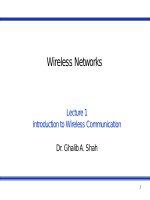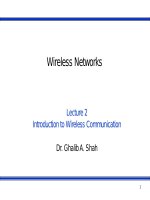Wireless networks - Lecture 30: QoS in WLAN/Mobile IP
Bạn đang xem bản rút gọn của tài liệu. Xem và tải ngay bản đầy đủ của tài liệu tại đây (1.01 MB, 32 trang )
Wireless Networks
Lecture 30
QoS in WLAN / Mobile IP
Dr. Ghalib A. Shah
1
Outlines
Last lecture
Limitations of QoS in IEEE 802.11
Overview of 802.11e
Traffic Categories
EDCF
HCF
Mobile IP
►
►
►
►
►
Care-of-address,
MIP Protocol (Discovery, Registration, Tunneling)
Routing
Inefficiencies
MIPv6
2
Last Lecture
Types of Attack
Goals of 802.11 Security
► Access control, data integrity, confidentality
WEP Protocol
WEP Authentication
Security flaws in original 802.11
► Physical threat, impersonation, mutual authentication,
dictionary attacks, DOS
802.1x Security
► AKM Operations with AS
► AKM operations with PSK
IBSS Security model
3
QoS Limitations of 802.11
DCF (Distributed Coordination Function)
► Only support best-effort services
► No guarantee in bandwidth, packet delay and jitter
► Throughput degradation in the heavy load
PCF (Point Coordination Function)
► Inefficient central polling scheme
► Unpredictable beacon frame delay due to
incompatible cooperation between CP and CFP
modes
► Transmission time of the polled stations is unknown
4
Overview of 802.11e
Formed in Sep. 1999. TheQoSbaseline
document was approved in November 2000.
The first draft was available in late 2001.
Aim to support both IntServ and DiffServ
New QoS mechanisms
► EDCF (Enhanced DCF)
► HCF (Hybrid Coordination Function)
Backwardly compatible with the DCF and PCF
5
QoS is realized by introducing traffic categories
(TCs)
MSDUs are delivered through multiple backoff
instances running as virtual stations
► Each instance is parameterized with TC specific
parameters
• AIFS, CWmin, CWmax, Persistance factor (PF)
► For legacy DCF, AIFS=DIFS, PF=2, CWmin <15
► CWnew[TC] =(CWold[TC]+1) x PF -1
6
0 <=I <=j <=3 I, j are AC [0,1,2,3]
CWmin[i] >=CWmin[j], CWmax[i] >=CWmax[j], AFIS[i] >=AFIS[j]
7
8
EDCF (Enhanced DCF)
Enhanced DCF
Also support bursting
Different parameters for different TC/AC
Replace DIFS with AIFS (AIFS>DIFS) which is shorter
for audio and video traffic.
► Audio =Video
CWmin and CWmax
► Audio
Different Persistence Factor (PF)
For EDCF, AIFS>=DIFS, PF=1-16, CWmin=0-255
9
10
HCF (Hybrid CF)
Provides policing and deterministic channel
access by controlling the channel through the
HC (Hybrid Coordinator)
Operate in CFP and CP
11
Detecting the channel as being idle for PIFS,
shorter than DIFS, gives the HC high priority
over EDCF
HCF model can provide Guaranteed Services
with a much higher probability than pure EDCF
A signaling protocol can be used to facilitate
admission control and specify service rate
requirement
12
Mobile IP: Basics
Proposed by IETF (Internet Engineering Task
Force)
► Standards development body for the Internet
Mobile IP allows a mobile host to move about
without changing its p e rm ane nt IP address
Each mobile host has a ho m e ag e nt on its ho m e
ne tw o rk
Mobile host establishes a c are o f address when it's
away from home
13
Example
Network B
Foreign Agent
Home
network A
Internet
Home Agent
Network C
Mobile Node
Corresp.
Node C
slide by Konidala M. Divyan [3]
Mobile IP: Basics, Cont.
Co rre s p o nd e nt ho s t is a host that wants to send
packets to the mobile host
Correspondent host sends packets to the mobile
host’s IP permanent address
These packets are routed to the mobile host’s
home network
Home agent forwards IP packets for mobile host to
current care-of address
Mobile host sends packets directly to
correspondent, using permanent home IP as
source IP
15
Mobile IP: Care-of Addresses
Whenever a mobile host connects to a remote
network, two choices:
► care-of can be the address of a fo re ig n ag e nt on the
remote network
• foreign agent delivers packets forwarded from home
agent to mobile host
► care-of can be a temporary, foreign IP address obtained
through, e.g., DHCP
• home agent tunne ls packets directly to the temporary
IP address
Regardless, care-of address must be re g is te re d
with home agent
16
Mobile Node registers at its Home Agent
Network B
Network A
Foreign Agent
Internet
Home Agent
Mobile Node
Network C
Mobile Node sends Binding Update
Home Agent replies with Binding Acknowledgement
slide by Konidala M. Divyan [3]
Corresp.
Node C
Protocol
In order to support mobility, Mobile
IP includes three capabilities:
1. Discovery
2. Registration
3. Tunneling
18
Discovery
Mobile Agents send ICMP router advertisements with
mobility agent advertisement extension periodically
informing mobile nodes of its presence.
Mobile node is responsible for the discovery process.
In order to receive an advertisement, the mobile node
may optionally request one from an agent or simply
wait for the next advertisement.
19
Registration
Mobile node recognizes that it is on a foreign network,
acquires a Care-of-Address and requests its home
agent to forward its data packets to the foreign agent.
The process of registration requires 4 steps:
1. Mobile node request forwarding service by
sending registration request to the foreign
agent.
20
Registration
2. Foreign agent relays this request to the home
agent.
3. Home agent accepts or denies the
request and
sends registration reply to
the
foreign agent.
4. Foreign agent relays this reply to Mobile
node.
21
Tunneling
After registration, an IP tunnel is set up between the
home agent and care-of-address of the mobile node.
Home agent broadcasts gratuitous ARP request which
causes all nodes in the subnet to update their ARP
caches to map the mobile nodes IP address to the
home agents link level address.
Thus home agent receives packets destined to the
mobile node, and forwards the packets to the foreign
agent through the IP tunnel.
22
Tunneling
In the foreign network, decapsulation is done by the
foreign agent or by the mobile node itself.
A correspondent node assumes that the reply from the
mobile node is coming from its home network and
continues to send the packet to the home agent.
23
IP-in-IP Tunneling
Packet to be forwarded is encapsulated in
a new IP packet
In the new header:
► Destination =care-of-address
► Source =address of home agent
► Protocol number =IP-in-IP
IP header
data
IP header
IP header
data24
Triangle Routing (Mobile IPv4)
Network A
Network B
Internet
Mobile Node
Home Agent
Network C
Corresp. Node C initiates communication with Mobile
Node and sends packets to MN‘s home address
Home Agent intercepts packets and forward them to
the Mobile Node (proxy functionality)
Mobile Node replies directly to Corresp. Node C
slide by Konidala M. Divyan [3]
Corresp.
Node C









